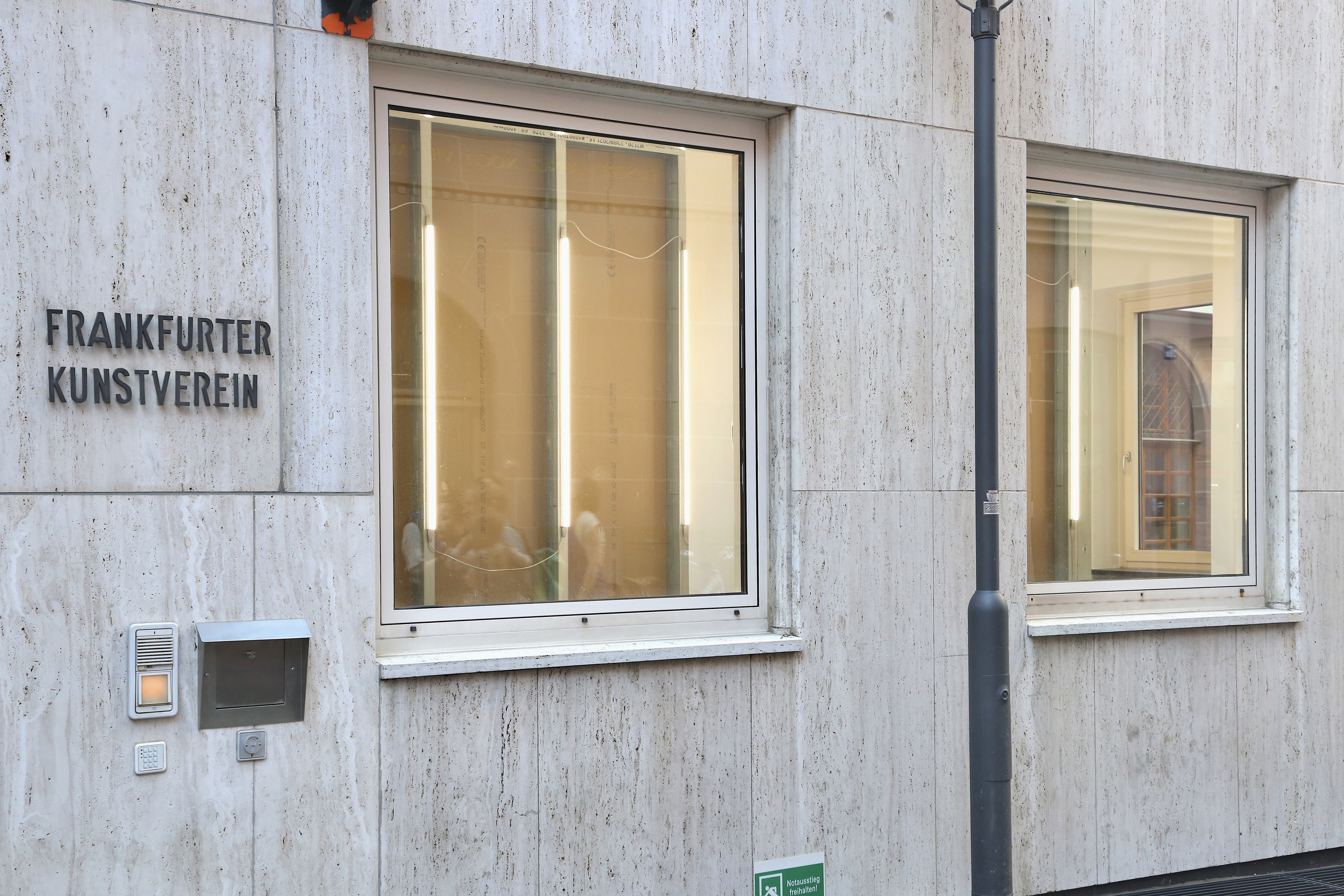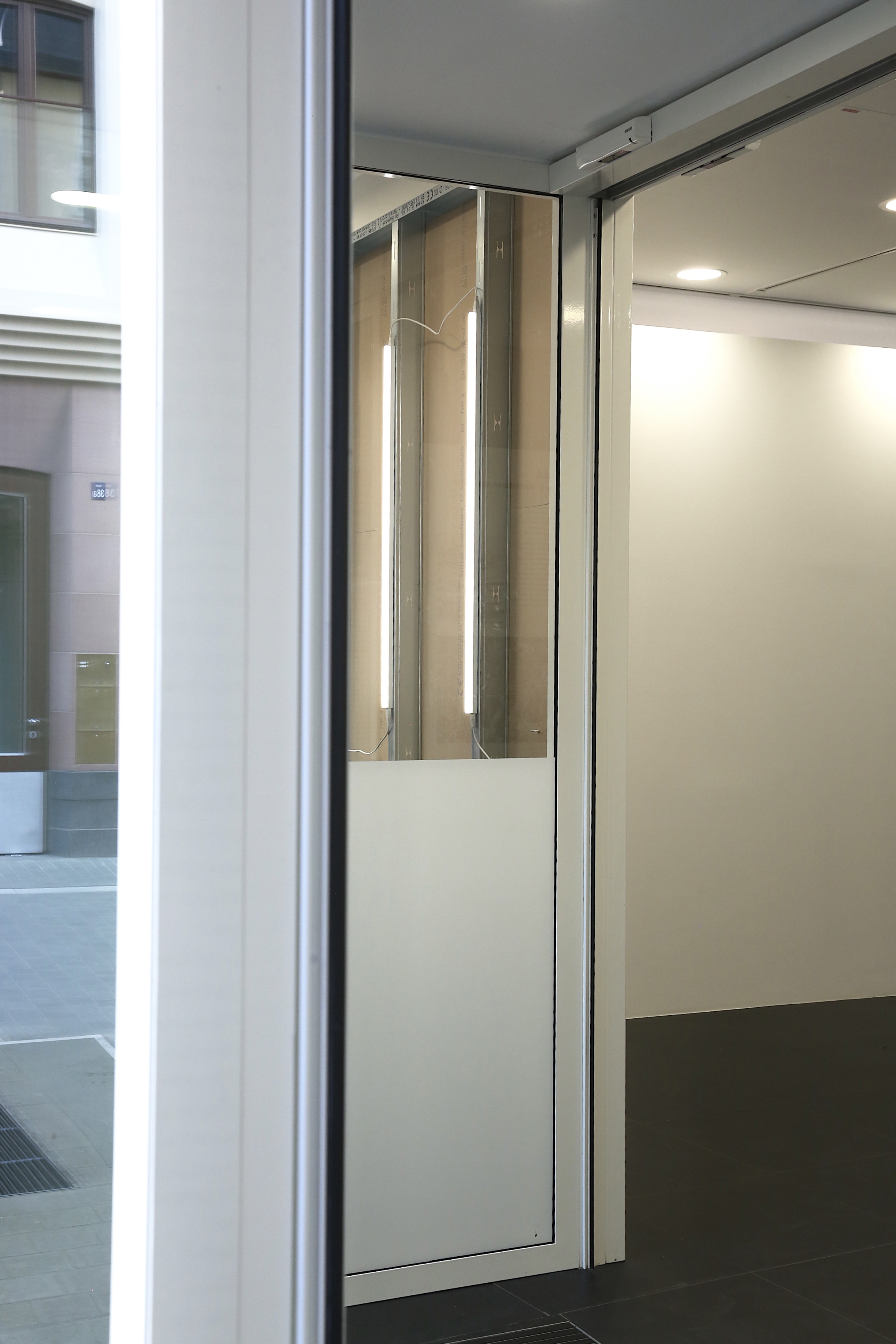A Window Is a Space
Installation
Frankfurter Kunstverein
Mai 2022
Trockenbauwand vor den Fenstern des Foyers,
LED-Leuchtstoffröhren
Konzept:
Clara Maria Blasius, Carlotta Döhn, Josefine Köhler
Fotos:
Clara Maria Blasius, Josefine Köhler
Die Wand verweist und vergleicht, verdeckt und öffnet. Sie ist Struktur und Objekt, agiert zugleich als Subjekt, indem sie den Raum aktiv begrenzt, Durch- und Ausblicke lenkt und Nichtsichtbares aufzeigt. An die Gebäudehülle anknüpfend versagt die Wand die Öffnungen, nach denen sie zu verlangen scheint. Als architektonisches Element und im Kontext des Kunstvereins berührt sie per se Fragen nach Zugänglichkeit. Sie umschließt und schließt ein, manchmal aus. Wem dienen diese Räume? Letztlich: Wem gehört die Stadt?
Die räumliche Intervention basiert auf Recherchen zum partiellen Wiederaufbau des Steinernen Hauses und den Um- und Anbaumaßnahmen der Sechzigerjahre. Der von der rekonstruierten Fassade entkoppelte Innenraum macht auf Brüche in den von nichtlinearen Geschichtsverständnissen getrennten historischen und ideellen Narrativen aufmerksam. Umgeben von der „Neuen Altstadt“, deren Architektur eine nahtlose Anknüpfung an die Zeit vor 1920 suggeriert, erweist sich auch diese Fassade als trügerisch. So kommt den Fenstern des ehemaligen Zwischengeschosses, der sogenannten Bobbelage, nunmehr ein nostalgisch dekorativer, jedoch kein funktionaler Nutzen zu. Dieses illusorische Moment der Fensterattrappen wird mit der Wand zitiert.
Der Eingriff produziert einen Raum zwischen Innen und Außen, der – wie das Foyer selbst – eine Schwelle markiert. In diesem verkörperten Dazwischen öffnet sich ein Spannungsfeld, welches Bezüge zu Diskursen um räumliche Autoritäten, zeitliche Kontinuitäten, institutionelle Konventionen sowie soziale Konstrukte herstellt. Die von der Wand gebildeten Räume werfen Fragen an ihre Umgebung auf und bieten zeitliche sowie räumliche Gelegenheiten, diese zu reflektieren.
The wall refers and compares, hides and opens. It is both a structure and an object, acting as a subject by actively defining the space, guiding views and perspectives and revealing the invisible. Following on from the building structure, the wall denies the openings it seems to demand. As an architectural element and in the context of the Kunstverein, it addresses questions of accessibility per se. It includes and encloses, sometimes excludes. Who do these spaces serve? Ultimately, who does the city belong to?
The spatial intervention is based on research on the partial reconstruction of the Stone House and the remodelling and additions of the 1960s. The interior, decoupled from the reconstructed façade, draws attention to breaks in the historical and ideal narratives. Surrounded by the "New Old Town", whose architecture suggests a seamless link to the time before 1920, this façade also proves to be deceptive. The windows of the former mezzanine floor, the so-called “Bobbelage”, now have a nostalgically decorative, but not a functional use. This illusory moment of the window dummies is cited with the wall.
The intervention produces a space between inside and outside, which - like the foyer itself - marks a threshold. The spaces formed by the wall raise questions about their surroundings and offer temporal and spatial opportunities to reflect on them.
Die räumliche Intervention basiert auf Recherchen zum partiellen Wiederaufbau des Steinernen Hauses und den Um- und Anbaumaßnahmen der Sechzigerjahre. Der von der rekonstruierten Fassade entkoppelte Innenraum macht auf Brüche in den von nichtlinearen Geschichtsverständnissen getrennten historischen und ideellen Narrativen aufmerksam. Umgeben von der „Neuen Altstadt“, deren Architektur eine nahtlose Anknüpfung an die Zeit vor 1920 suggeriert, erweist sich auch diese Fassade als trügerisch. So kommt den Fenstern des ehemaligen Zwischengeschosses, der sogenannten Bobbelage, nunmehr ein nostalgisch dekorativer, jedoch kein funktionaler Nutzen zu. Dieses illusorische Moment der Fensterattrappen wird mit der Wand zitiert.
Der Eingriff produziert einen Raum zwischen Innen und Außen, der – wie das Foyer selbst – eine Schwelle markiert. In diesem verkörperten Dazwischen öffnet sich ein Spannungsfeld, welches Bezüge zu Diskursen um räumliche Autoritäten, zeitliche Kontinuitäten, institutionelle Konventionen sowie soziale Konstrukte herstellt. Die von der Wand gebildeten Räume werfen Fragen an ihre Umgebung auf und bieten zeitliche sowie räumliche Gelegenheiten, diese zu reflektieren.
The wall refers and compares, hides and opens. It is both a structure and an object, acting as a subject by actively defining the space, guiding views and perspectives and revealing the invisible. Following on from the building structure, the wall denies the openings it seems to demand. As an architectural element and in the context of the Kunstverein, it addresses questions of accessibility per se. It includes and encloses, sometimes excludes. Who do these spaces serve? Ultimately, who does the city belong to?
The spatial intervention is based on research on the partial reconstruction of the Stone House and the remodelling and additions of the 1960s. The interior, decoupled from the reconstructed façade, draws attention to breaks in the historical and ideal narratives. Surrounded by the "New Old Town", whose architecture suggests a seamless link to the time before 1920, this façade also proves to be deceptive. The windows of the former mezzanine floor, the so-called “Bobbelage”, now have a nostalgically decorative, but not a functional use. This illusory moment of the window dummies is cited with the wall.
The intervention produces a space between inside and outside, which - like the foyer itself - marks a threshold. The spaces formed by the wall raise questions about their surroundings and offer temporal and spatial opportunities to reflect on them.








